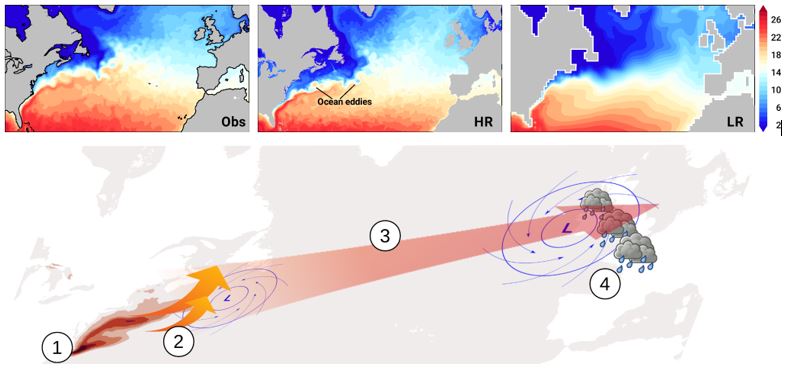BSC scientists, in collaboration with the Met Office, studied the European climate in coming decades in model simulations with a pioneering degree of realism.
Rainfall in Europe during the winter season could increase by around 20% in the next 30 years if greenhouse gases continue to be emitted at the current level. This is the conclusion of a new study, published in Environmental Research Letters, which has been led by BSC’s researchers Eduardo Moreno-Chamarro, Louis-Philippe Caron, Pablo Ortega, and Saskia Loosveldt Tomas, in collaboration with Malcolm J. Roberts from the Met Office, the United Kingdom's national weather service. Based on new high-resolution climate models with a higher degree of realism than traditional ones, the research could change the current understanding of how climate can change over Europe and the North Atlantic.
The reason why the new high-resolution climate models project this remarkable increase in precipitation compared to traditional models is a different response over the Gulf Stream region, which would experience strong surface warming associated with a northward shift. The Gulf Stream is the warm surface current that transports waters from the Gulf of Mexico to the western European coasts and that helps to temper the European climate compared to other areas of similar latitude. The new models project warming of the region up to about 7 °C by 2050 compared to the mid 20th century.
“Such a strong warming is behind all the changes in precipitation we see over Europe”, Eduardo Moreno-Chamarro, lead author of the study, remarks. He continues: “The warming pumps heat from the ocean into the atmosphere, favoring the formation of low pressure systems over the North Atlantic. These lows are ultimately responsible for bringing more precipitation over northwestern Europe.”
More realistic climate models
Climate models are the fundamental tool climate scientists use to study future climate change. These models use basic equations of physics and chemistry to represent the processes and interactions driving the Earth’s climate. When run into the future, climate models are forced by estimates of how greenhouse gas concentrations might change in the atmosphere with time.
The realism of a climate model is set by its resolution: finer resolution models can resolve more physical processes and interactions and are so expected to be more realistic (note the much closer agreement between observations and the HR model compared to the lower resolution one in the top panel of the figure below). Model resolution (realism) can critically change scientists’ understanding of the future climate change because new or better resolved processes might respond differently to the projected increase in greenhouse gas concentrations. This is why scientists always try to run their models at the highest resolution possible.
However, increased resolution makes simulations computationally more expensive and demands more powerful and faster supercomputers, like Marenostrum at Barcelona Supercomputing Center (BSC). Only in the past few years, computing power has increased enough to allow a handful of pionering climate modeling centers to run simulations of the future using global models at extremely high resolutions, capable of resolving ocean eddies, this is small-scale circular currents (highlighted in the top panel of the figure below). Such simulations, whose resolution is about 10 times finer than the traditional one used to inform policymakers about the potential risks of climate change, can provide a new perspective of potential climate changes.
Implications of the research
The results of the study have important implications for the assessment of the risks of climate change in many socio economic activities in Europe, including water management, settlements, navigation, trade, and wind energy production. These risks are usually evaluated using the lower-resolution models that, in this study, project much muted increases in precipitation and low pressure system formation. These findings suggest that these models could actually be underestimating the potential risks for Europe.
The study also underlines the importance of using climate models of increased fidelity to address key open questions in climate change science for the future. Pablo Ortega, co-lead of the Climate Prediction group at BSC, stresses: “These models present a future that is quantitatively different from what the traditional models have been suggesting, with regions like the Gulf Stream experiencing extraordinary warming”. He continues: “But more importantly, they also anticipate important changes in the behaviour of the ocean circulation with implications for the weather conditions that we experience in our daily lives”. Only with such models, scientists will be able to improve our understanding of climate change on a smaller, regional scale and produce better informed adaptation and mitigation policies.
Reference: E Moreno-Chamarro et al 2021 Environ. Res. Lett. 16 054063 https://doi.org/10.1088/1748-9326/abf28a

Figure: (Top row) Snapshot of monthly ocean surface temperature (in °C) for the North Atlantic region in observations (left) and in the global models at an eddy-resolving resolution (middle; HR for high-resolution) and a traditional lower resolution (LR; right). (Bottom row) Schematic of the chain of events linking the Gulf Stream warming (1) and the precipitation increase over Europe (4). The Gulf Stream warming makes the atmosphere more unstable and more favorable to the formation of low pressure systems (2). These lows continue to grow over the North Atlantic (3), eventually bringing more rainfall to Europe.

